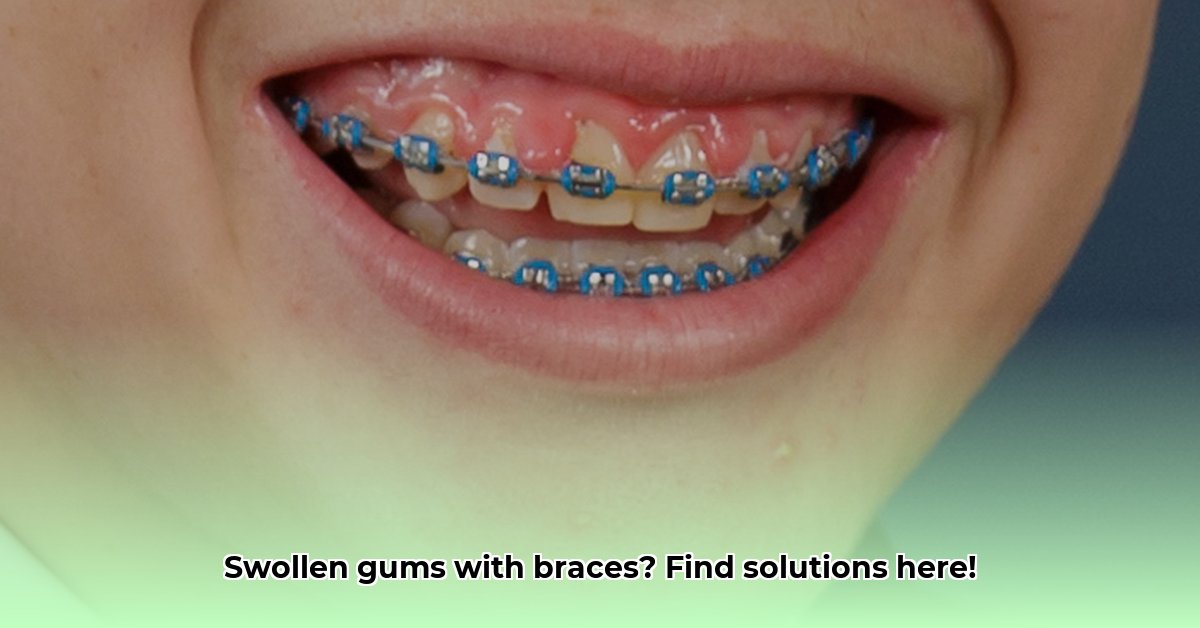Got puffy, sore gums thanks to your braces? You’re not alone! It’s normal to experience some gum swelling with braces, but excessive swelling can be uncomfortable. This guide is your friendly resource for understanding, managing, and preventing gum issues during your orthodontic journey.
Why Are My Gums Swollen?
Common Culprits Behind Brace-Related Gum Swelling
Braces, while working their magic to straighten your teeth, can sometimes irritate your gums. Think of it like remodeling a house – there’s bound to be some dust and disruption. Here’s what commonly causes gum swelling with braces:
- Plaque Buildup: Braces create nooks and crannies where plaque, that sticky film of bacteria, can hide. If not removed properly, plaque irritates your gums, leading to inflammation (gingivitis).
- Food Traps: Bits of food easily get stuck around braces, further fueling plaque buildup and irritation.
- Teeth Movement: As your braces shift your teeth, your gums need to adjust, which can cause temporary swelling.
- Gingival Hyperplasia: In some cases, the gum tissue itself grows larger, a condition called gingival hyperplasia. This overgrowth, though usually benign, makes cleaning more challenging.
- Hormonal Changes: Puberty, pregnancy, or other hormonal shifts can make gums more sensitive and prone to swelling.
- Underlying Health Conditions: Certain medical conditions, like diabetes, may increase susceptibility to gum inflammation.
- Brace Irritation: Sometimes, the braces themselves can rub against your gums, causing friction and swelling.
- Allergies (Rare): While less common, some individuals might have an allergic reaction to materials in braces, leading to gum swelling.
Taming the Tenderness: Soothing Swollen Gums
At-Home Remedies for Relief
If your gums are feeling a bit puffy, try these home remedies:
- Warm Saltwater Rinse: Dissolve half a teaspoon of salt in a cup of warm water. Swish gently for 30 seconds, several times a day. Saltwater rinses are known for their soothing and cleansing properties.
- Gentle Brushing & Flossing: Use a soft-bristled toothbrush and floss threader or water flosser to clean carefully around braces.
- Over-the-Counter Pain Relief: Ibuprofen or acetaminophen can help manage discomfort. Follow package instructions and consult your doctor or pharmacist if you have any concerns.
- Cold Compress: Apply a cold pack wrapped in a thin cloth to your cheek for temporary relief.
- Soft Foods: Choose foods like yogurt, soup, and mashed potatoes to give your gums a break.
- Clove Oil (With Caution): A tiny drop of clove oil applied with a Q-tip might offer relief, but always consult your dentist first. Clove oil can be irritating if used incorrectly.
Professional Help: When to See Your Orthodontist
Signs It’s Time to Call In the Experts
While some swelling is normal, certain symptoms warrant a call to your orthodontist:
- Persistent Swelling: If swelling doesn’t improve with home care after a few days, or worsens, seek professional advice.
- Bleeding Gums: Occasional minor bleeding is normal, but persistent or heavy bleeding should be checked.
- Severe Pain: Mild discomfort is common, but severe pain isn’t and requires attention.
- Loose or Broken Braces: Contact your orthodontist immediately if any part of your braces breaks or comes loose.
Professional Treatments for Swollen Gums
Your orthodontist may recommend:
- Professional Cleaning: A deeper cleaning to remove stubborn plaque and tartar.
- Gingivectomy: Surgical removal of excess gum tissue in cases of gingival hyperplasia.
- Scaling and Root Planing: This may be necessary for more severe gum inflammation. It is only recommended in certain cases.
- Medicated Mouthwash/Gel: Prescription rinses or gels to control inflammation and infection.
- Addressing Underlying Health Issues: Collaboration with your physician if a medical condition contributes to gum swelling.
Prevention is Key: Keeping Your Gums Healthy
Your Daily Defense Strategy Against Swelling
- Mastering Braces Hygiene: Brush after every meal, paying close attention to the areas around braces. Floss daily with a floss threader or water flosser. Visual demonstrations for brushing and flossing with braces are widely available online. Consider searching for “brushing with braces video” or “flossing with braces tutorial” for step-by-step guidance.
- Smart Food Choices: Limit sugary and sticky foods that contribute to plaque buildup. Choose gum-friendly options like soft fruits, vegetables, and lean proteins.
- Regular Orthodontist Visits: Keep up with your scheduled appointments for checkups and professional cleanings.
Choosing the Right Oral Hygiene Tools
| Tool | Benefits | Considerations |
|---|---|---|
| Soft-bristled toothbrush | Gentle on gums; effective cleaning around braces | Replace every 3 months or sooner if frayed |
| Electric toothbrush | May be more effective at plaque removal; some models are specifically designed for braces | Consult your orthodontist for recommendations |
| Orthodontic floss/Floss threader | Essential for cleaning under wires and between teeth | Practice makes perfect! |
| Water flosser | Easier to use than traditional floss; reaches tight spots | May require some getting used to |
| Interdental brush | Cleans between teeth and around brackets | Use gently to avoid gum irritation |
| Fluoride rinse | Strengthens enamel, helps prevent cavities | Consult your dentist for recommendations |
| Antimicrobial mouthwash | May help control bacteria (use as directed by your dentist) | Not a substitute for brushing and flossing |
By following these tips and working closely with your orthodontist, you can keep your gums healthy throughout your braces journey and achieve the confident smile you deserve! Remember, ongoing research continues to explore the relationship between braces and gum health. Staying informed and communicating with your orthodontist are important for maintaining optimal oral health. They can provide personalized advice and address any specific concerns you may have. If you need help finding an orthodontist in your area, try searching online for “orthodontist near me.”
- The Best Bento Box Price For Your Perfect Packed Lunch - December 15, 2025
- Bento Box Shopping Tips for Smart and Stylish Lunch Prep - December 14, 2025
- Bento Box Trays Streamline Restaurant Meal Presentation and Transport - December 13, 2025










